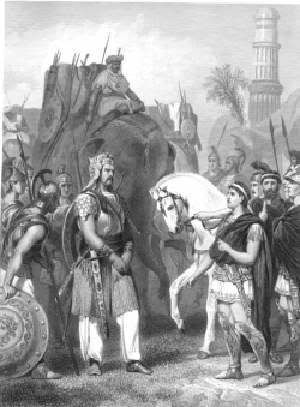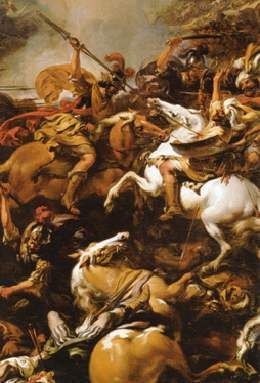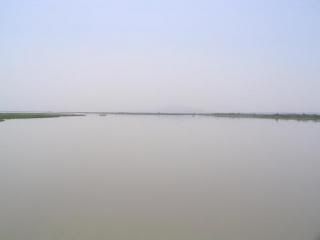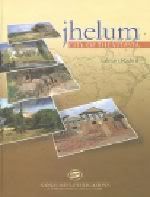 The name Jhelum reminds of Alexander from Macedonian who came to the South Asia sometime in 326 BC.
The name Jhelum reminds of Alexander from Macedonian who came to the South Asia sometime in 326 BC.
He moved from Taxila of Raja Ambhi, whom he subdued without fight, to Kalar Kahar. From there he moved over the Salt Range, turning left, along the western bank of River Jhelum, which he called Hydaspes. He encamped in area of present village Darapur
(a monument is under construction at the site of the camp). Opposite him on the other bank was a Raja Porus. They fought Alexander’s biggest Indian battle which Alexander won, achieving a masterly surprise against the valiant Rajput.
Before moving further, along the river Alexander established a village on west bank of the River and ordered construction of 2000 boats. Greek Admiral Nearches was to arrange wood from nearby higher hills which would be floated down the River and hauled up at this point. He called this village as Boucephila (Present Jhelum city). The Jhelum River passes vying with the residential areas of the city. The mosque inside the river is a famous landmark most commuters on the Grand Trunk Road see even today.
 Alexander’s Naval Chief was assigned the task of boats building on a very large scale. Therefore, the craftsmen on a large scale were gathered, hence the modern colonies in the city were named as Machine Mohallahs (Number1, 2 and 3), because of saw mills. Jhelum became timber market for whole of Punjab over the millenniums. It was only after construction of Mangla Dam that log wood does not float down the River and the city has lost this privilege. There is a plywood factory also, which is flourishing.
Alexander’s Naval Chief was assigned the task of boats building on a very large scale. Therefore, the craftsmen on a large scale were gathered, hence the modern colonies in the city were named as Machine Mohallahs (Number1, 2 and 3), because of saw mills. Jhelum became timber market for whole of Punjab over the millenniums. It was only after construction of Mangla Dam that log wood does not float down the River and the city has lost this privilege. There is a plywood factory also, which is flourishing.
Greeks left marks of their chivalry and martial spirit which mixed up well with the races and clans dwelling in the area. Later, various races such as Turks, Hunas, Persians, Afghans, Mongols, and others including Mehmood of Ghazana, Muhammad Ghauri, Taimur, Babar and their descendants and followers, are found to have campaigned in this strategic region enormously. People who settled here adopted pastoral life and indulged in stock rearing, agriculture came later and soldiering in regular form still much later. Along with the martial races sprang up the artisans, craftsmen, skilled professionals of technical trades for the society to flourish in peace, as a whole.
The British, after annexation of Punjab in 1849 from Sikhs, established administration at district level and Jhelum District, which originally was covering large area including Pindigheb and territory up to River Indus, was delimited later to include tehsils of Jhelum, Chakwal and Pind Dadan Khan, with District Head Quarters shifting from Pind Dadan Khan to Jhelum. During the 20th Century, this city has a proud history of chivalry and achievements.
During World War I, Jhelum provided maximum number of soldiers as a result of which the British recruited very extensively from Jhelum, till their last days of rule. First Victoria Cross, the highest award for gallantry was earned by Subedar Khuda Dad Khan during World War I. Later its equivalent (Nishan-e-Haider) of Pakistan has been won by Major (Shaheed) Raja Muhammad Akram during our war of 1971. At the time of partition of the subcontinent, three out of four senior major generals of Pakistan Army were from Jhelum: Major General Muhammad Akbar commonly known as “recruit⠀�, Major General Nazir Ahmed and Major General Muhammad Iftekhar. Senior most Pakistan Air Force officer was Air Commodore Muhammad Khan Janjua, also from Jhelum.
Later rose up two service chiefs with four star rank, General Asif Nawaz Janjua and Admiral Tariq Kamal Khan. Colonel Muhammad Khan, the author of Bajang Amad and Bazam Araian, and poet Zamir Jafri too have their roots here. Inder Kumar Gujral, who later served as Indian Prime Minister, migrated to India from Jhelum. Military College Jhelum (actually located at Srai Alamgir – town across River Jhelum) was established during the British era. Stone laying was done by the British Prince of Wales, later king Edward the 8th. First entry of students, in 1925, included ‘Alamigirian seniors like Brig Sultan Khan and Brig (Senator) Muhammad Hayat. The institute is now the premier one with top class results, in the country, academically.
Military College Jhelum (actually located at Srai Alamgir – town across River Jhelum) was established during the British era. Stone laying was done by the British Prince of Wales, later king Edward the 8th. First entry of students, in 1925, included ‘Alamigirian seniors like Brig Sultan Khan and Brig (Senator) Muhammad Hayat. The institute is now the premier one with top class results, in the country, academically.
During Pakistan’s wars, officers and other ranks excelled in their performances and a very large number of gallantry awards were won. One has to read Citations of such acts of valour. Then pre World War II and during that war, the number of Junior commissioned officers (earlier-Viceroy Commissioned) who rose to honorary ranks of lieutenants and captains would run into hundreds. Predominance in Defence Services continues and so is service to country.
The people of Jhelum are not sweet for nothing; they have the best quality of Rush Orange (Lockat) grown in salt range. The Jhelum valley (Pabbi area and parts of Salt Range) has been producing pure honey which is rare. In early days, some Yogies and men who indulged in medicine practice had established a centre at Tilla Jogi, because of special growth of useful herbs and plants. Another sweet preparation, a gift from the central square in the city is called ‘Amrassaâà ¢â€šÂ¬Ã¢â€žÂ¢. This sweet is a roasted preparation of rice flour, in pure milk ghee and is usually in small pieces like candies. It is sweet enough only for the taste and is hardly a bar even for diabetics. It is long lasting and its packs would make fine gifts. Do not miss this sweet when visiting Jhelum.
 Jhelum is known for variety of animals and birds and some rare species of deer (huryal). Emperor Jahangir availed of deer shoot in the eastern extremities of the Salt Range (near Rohtas). It is still available but rare. Thanks to unlawful hunting that this specie is at the verge of extinction. Brown partridge, pigeons, sand grouse, quails and some other birds are still to be found. And for bird watchers, there is no other place in this region having such a variety. It is just heavenly a large variety of hymning birds, numerous species of beautiful little sparrows, multi-coloured birds of various sizes, king fishers, birds of falcon family, green parrots, wood peckers, birds of peace, robins. This region provides food and sanctuaries to all of them. Early morning tunes (starting at pre dawn) of their routine singing activity is a treat that can only be personally experienced.
Jhelum is known for variety of animals and birds and some rare species of deer (huryal). Emperor Jahangir availed of deer shoot in the eastern extremities of the Salt Range (near Rohtas). It is still available but rare. Thanks to unlawful hunting that this specie is at the verge of extinction. Brown partridge, pigeons, sand grouse, quails and some other birds are still to be found. And for bird watchers, there is no other place in this region having such a variety. It is just heavenly a large variety of hymning birds, numerous species of beautiful little sparrows, multi-coloured birds of various sizes, king fishers, birds of falcon family, green parrots, wood peckers, birds of peace, robins. This region provides food and sanctuaries to all of them. Early morning tunes (starting at pre dawn) of their routine singing activity is a treat that can only be personally experienced.
Jhelum Work Force which moved into the Gulf States when the latter embarked on their development, financed by oil boon. This force is second to none. There are people of all trades and technologies. The reputation this Work Force has earned makes it most desired. Besides the Middle East, Pakistanis, including medical and engineering fields, are serving well in the US, Canada, Britain and other European countries. Only no body is taking pains to develop the human resources of the country optimally.
It is generally believed in the area that British were really intrigued by one phenomena that people of a particular plateau or valley were found to be tall and strong so they conducted a research; only to come to conclusion that it was the “waterâà ¢â€šÂ¬Ã‚? and ‘saltââ� �€šÂ¬Ã¢â€žÂ¢ of that particular area which is the secret.
The Grand Trunk Road and main Karachi Peshawar Railway Track pass through the city. Commuters can have a feeling of the town once they cross through. Besides history, the city has a rural touch and nothing much have changed here during last couple of decades.



















































[…] We left Islamabad around 2 pm. We originally had plans to visit Rohtas, Katas Temple and Tulip restaurant at the Jhelum river toll point. It took us quite some time to reach Rohtas due to traffic enroute. Interesting point here is that we traveled the same road (G.T Road) that Sher Shah built over four centuries ago. […]
“I have been visiting this interesting site from time to time as I did my doctoral research on Pakistani history and culture, and have been a regular visitor to your warm and hospitable country since 1995.”
Sophia L Duvenant: Happy to know that you are a scholar of Pakistan history and culture. Have you published your material yet. Please share your thoughts with us. Hope to hear more from you on this or other serious sites. Thanks.
MQ:
I did state in my comments that I am not sure if its a fact, theory or a myth. I also stated that many scholars believe that, ofcourse not everyone belives it. I did not say that there is a mention of Alexander/Sikandar by name as such in Quran. We all know that in Quran, many things/incidents are not narrated very conceretly. So its not a bad idea to discuss it.
Regards.
Moeen Bhatti Sahib,
As far as I know there is no mention of Alexander or Sikandar in the Quaran. There is a mention of one Zulqarnain, though, in two or three places. Zulqarnain literally means “one with two horns”. Abdullah Yousuf Ali conjectured that Zulqarnain was Alexander. Probably few other scholars believed that too. But it is only a conjecture. A lot of Muslim scholars don’t agree with this interpretation.
Whether Alexander was a Muslim (??) or a pagan is altogether a new discussion and let’s not get into that because we will be distracting from an otherwise interesting and informative post.
Jayjay:
There seems to be a reason that scholars think that Alexander could be a muslim; there is no reason to believe that Aristotle or Archiemedes could be muslims too. I mentioned this because I do find it interesting, I am not trying to confirm historical facts here. I guess you did not refer to the surah. Please refer to Surah 18, verse no 86. The King has been addressed as “O Dhu al Qarnayn” meaning “Thou hast authority.” There is also mention of “In a spring of murky water” and this ref. is easily understood to be the Lychnitis(now Ochrida), west of Macedonia. It is fed entirely by underground springs in a limestone region, where the water is never very clear. I am writing these ref. from the translation of Quran by Abdullah Yusuf Ali.
About Blue eyes, its a polygenic triat which is inherited by more than one gene. There are 3 loci associated with eye color, EYCL1, EYCL2 and EYCL3. Eye color is maily determined by amount & type of pigment. Only 8% of the world population has blue eyes, and they are common through out europe, which also includes Greece. The highest proportion of blue eyes are found in Finland & Luthuania. This is all published data.